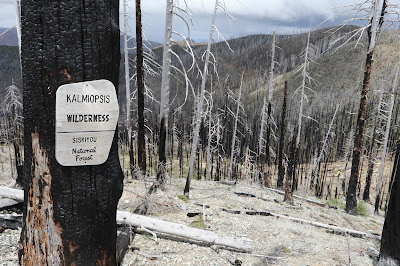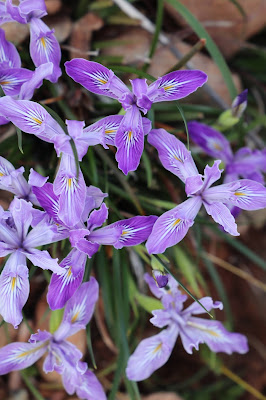Have you ever gone somewhere nearby that almost seems otherworldly? Have you ever traipsed out into your backyard only to find something foreign and unknown?
In 1987 I was in southwest Oregon for work, helping save the world as a wildfire suppressor. I thought it would be nice to return and see the place in a different light, in other words, in the non-smokey light of a bright sun. Thirty-four years later I did get back and we backpacked into the Kalmiopsis Wilderness Area.
Shouldn't have waited sooo long.
 |
| The edge of the Wilderness. |
The parking lot was deserted, empty, and nobody was around when we left the Babyfoot Lake trailhead and headed south. The trail had been maintained a year or two earlier, so it was no surprise to have to climb over a couple downed snags. There were flowers everywhere, mostly on the shrubs, but also many of the forbs were in full flower.
The two nights we spent were near the site of Bailey Cabin. There had been a long history, some very recent, of mining in the area. Many of the trails had been roads to mines.
 |
| Leftovers from the mining heydays. |
And then there were the wildfires. The wildfire I was a part of trying to suppress was a little ways north of where we backpacked. This area had been burnt in the 2002 Silver Fire. There may have been another some years later, but the fact is that most of the conifer overstory was in the form of dead snags. Some people may be saddened to see so many dead trees. We were rejoicing at the response of the plant life resulting from the pulse of nutrients from the burned biomass. The shrubs and other plants were resplendent this time of year.
 |
| Kalmiopsis leachiana |
How many wilderness areas are named for a plant? Usually the name reflects a local geologic feature--a mountain or river such as Mount Jefferson Wilderness, or North Fork Umatilla Wilderness. Occasionally an area is named for a famous person, hence The Bob Marshall Wilderness. But what about plant names for wilderness areas? In Oregon there is one, and one only, Wilderness Area named for a plant, Kalmiopsis. The plant, a small shrub in the heath family that is found in southwest Oregon, was in full flower when we visited.
Other plants were also splendidly displayed. Rhododendron, azalea, ceanothus, current, and even poison oak. Not all of the overstory had been burnt in the wildfires, but it was mostly sparse.
 |
| Walking through a Jeffrey pine forest. |
Was this what the area looked like before Euro-Americans started suppressing wildfires? Some of the conifers in the area, such as knobcone pine, require fire for their cones to open and release their seeds.
On the second day we day hiked down to the mighty Chetco River. We would have gone on, pushing north along the river, but soon encountered a wall of poison oak. Fifty percent of our party is very susceptible to developing dermatitis from the oils of poison oak, so we turned around. After a leisurely lunch along the turquoise blue Chetco we wandered back to base camp, peak bagging Bailey Mountian on the return.
 |
| The mighty Chetco River. |
 |
| Nighttime camp near Bailey Cabin site. |
 |
| Looking north across much of the Kalmiopsis Wilderness Area. |
We hiked out the ten kilometers on the third day. We were within two kilometers of the trailhead when we saw the only other people of the trip--Gabe and his friend were starting a 5 day loop.
 |
| Hiking past the Ribes. |
 |
| California lady slipper. |
It was a great three days. But the standard disclaimer applies: Don't go there. Stay away. This place is not for you.
Don't go there because you can see the flowers right here. I leave you with some of the outstanding flora of the Kalmiopsis Wilderness Area.
 |
| This is the flower of the California pitcher plant (Darlingtonia californica). |
 |
| Douglas' iris (Iris douglassii) |
 |
| Large flowered rhododendron (Rhododendron macrophyllum) |







































